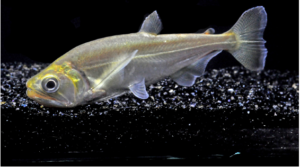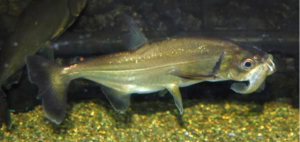Fish from the genus Hydrolycus have always been a great fascination for exotic fishkeepers. The distinct feature that draws fishkeepers to fish from this genus is the pair of oversized fangs that grows from its lower jaws. Known as the Dogtooth Characin or Vampire Tetras, these fish are on the wish list of many fishkeepers. No other fish possesses these menacing fangs; thus, demand for Hydrolycus fish has always been high, regardless of the species. The genus Hydrolycus is a group of large South American tetras quite popular with sports anglers as a ferocious gamefish and a highly esteemed aquarium fish for monster fishkeepers. The genus is represented by four species, namely, H scomberoides, H tatauaia, H wallacei, and H armatus.
Of the four species, H wallacei is a species I have never seen, ever. I have not even heard of anyone having one in the Philippines. So this fish remains a mystery to me. As for the other three species, I have at one time or another kept some at home. H scomberoides was the first to be ever introduced in the country. In my recollection, I have seen this species way back in the 1990s and I remember having a few in my home aquarium. H tatauaia is the most colorful in the genus due to its red fins. Both species are available locally, but not very often.
The Big Favorite
Easily my favorite among the four is the H armatus. This is the real deal: a beast and a real monster fish that will make your jaw drop at first sight. Many fishkeepers are enamored with the idea of owning an H armatus because this is an extraordinary fish like no other. It is a monster fish in every sense of the term.
It is huge, menacing, and clearly a top-of-the-food-chain kind of fish. Once it flashes those fangs—and sometimes, even with just the sight of its picture—fishkeepers with a liking for monster fish know they just have to get one. The Hydrolycus armatus was first described by Scottish naturalist Sir William Jardine in 1841. It got its genus name, Hydrolycus, from the Greek words ‘hydro’, meaning water, and ‘lykos’, meaning wolf. Its species name, armatus, is from the Latin word ‘armatus’, meaning ‘armor, armed, or armored’, presumably in reference to its fearsome teeth.
H armatus are naturally found in the waters of northern South America, specifically the Rio Orinoco drainage and the vast, winding rivers of the Guyanas. They are mostly found in stretches of the river with fast flowing water. In its locality, it is commonly called the ‘Payara’, where it is also a valuable food fish owing to its large size. In the fishkeeping hobby, the H armatus is known as the ‘Giant Payara’ and is the largest of the Hydrolycus species, with specimens reaching over 3 feet and weighing about 15 kilos in the wild. In captivity, it can be expected that they will not grow as large, but 30 inches is realistically attainable, especially in very large tanks.
Teething Tales

The fangs of the H armatus are, of course, very impressive. Since it is the largest species in the genus, it also has the largest fangs among the four. With adults, these teeth grow up to 4 or 5 inches. These teeth are so long that H armatus as well as others in the genus develop holes in their skulls where the teeth can safely be kept when the mouth is shut. Otherwise it would be too long and might pierce their brains. For younger specimens, these teeth are used to spear the prey and hold on to it as the fish maneuvers the prey for swallowing.
I was once pierced by the teeth of a 4-inch H armatus, and it felt like a needle had pierced through my skin. For larger specimens, however, the fangs and the powerful jaw can slice a fish in half. By the way, these teeth do break once in a while and will be replaced by new and longer ones. So don’t worry much if you see them break their teeth. They will be replaced soon with bigger teeth.
Which is Which?
Positively distinguishing the H armatus from other species can be tricky as all four species look very similar. However, there are some key distinct features (I refer to these as KDFs, or features that differentiate it from another species) to look for in properly identifying H armatus.
While it is true that the H armatus is the largest among the four, size is not a good basis to use for identifying the fish. Of course, when they are young, they are all small. It is only when they are adults that differences in size are observable.Of the four species, H armatus is the only one with a red adipose fin with a black tip. The adipose fin is a small fin only present with Tetras and some catfishes, and it is located on the dorsal part to the rear of the fish before the tail. This KDF is unique to H armatus, and does not occur with the three other species.Another KDF of the H armatus is that it has a black band at the end of the tail. With the H scomberoides, this band is clear; in the H tatauaia, the tail is red; and with the H wallacei, the tail is black. Thus the black band at the end of the tail is another feature you look for to verify if the fish you are buying is an H armatus or not.
Tank Considerations

Owing to its large size, the H armatus can be a very challenging fish to keep. It will require a big tank. Of course they are normally available in the market as 3 to 4 inch cuties and may be placed in tanks as small as 20 gallons. But they will quickly outgrow these tanks, and you will eventually need one that is 300 gallons or more. There will never be a tank too big for an H armatus; after all, it lives in the largest river in the world. Just keep in mind that the H armatus will be better off in a bigger tank.
So if it is a choice between a 300-gallon tank and a 400-gallon tank, go for the 400. With large tanks come strong filter systems. To be able to process that amount of water, a sump filter matched with a pump with a good, strong flow rate seems like a good choice. Personally I prefer a sump filter with a capacity of at least 20% of the main tank. If the tank is 300 gallons, then a sump filter of 60 gallons is my minimum sump capacity. A bigger sump is, of course, most welcome.
The Bigger, the Better
Smaller sized H armatus may be challenging to keep. Fishkeepers swear that at a small size, they are not hardy and the mortality rate is rather high. Many have been discouraged when they buy small ones. H armatus are all imported and the smallest specimens I have seen to arrive in the country are a mere 2 to 3 inches. At this size, they are very difficult to keep. On the other hand, specimens over 6 inches are more robust and quite easy to keep.
They are hardy and do not require any special fishkeeping techniques. Simply stick to basic fishkeeping rules, and you should be able to successfully keep them. H armatus are from the Amazon River, and as with fishes from the same river system, they prefer a water pH of 6.0 to 8.0, with water hardness of 36 to 268 ppm and a temperature range of 24°C to 30°C. Generally speaking, these water parameters are easily attainable for the average Filipino fishkeeper. The H armatus has a huge appetite; thus, their growth rate is quite amazing. This is a fish whose monthly growth will be visibly noticeable every month. Normally, it is your fellow fishkeepers who will notice that your fish has grown; but with the H armatus, believe me, you will notice their growth even if you see them daily.
How to Make H Armatus Play Nice

H armatus are primarily piscivorous and prefer to eat live fish. They normally stay low, near the bottom of the tank, and prefer to attack with a lightning quick jab at a prey fish swimming near the surface. A quick stab skewers its prey and the H armatus positions the fish head first as it swallows its prey. The H armatus has a big mouth and prefers big fish to small ones as food. In captivity, however, the H armatus can be taught to eat fresh fish from the market with relative ease. I guess their huge appetite does not make them choosy when it comes to food. So long as food is available, they will gladly eat it.
However, I noticed that they will not pick up food from the bottom of a tank. So I flip the fresh fish into the tank, tossing it on its side so that it will sink slowly to the bottom. Normally, the H armatus lunges at them with the same upward motion it uses when hunting. I do not toss the fresh fish in head first; otherwise, it will just sink straight to the bottom before the H armatus can catch it. Lastly, I always make sure the H armatus is looking forward as I toss the fish in front of it; otherwise, I will end up with so many fish lying at the bottom of the tank.
While the H armatus is indeed a monster fish its own right, it can be housed in the same tank with other fish if done with caution. The fishkeeper must respect the fact that the H armatus is a piscivore with a large mouth. Thus, any fish small enough to fit in the mouth will be considered as food. Its tankmates must be big enough not to be seen as prey. The H armatus will not attack other fish the way bad-tempered cichlids do. They will leave tankmates alone—but prey is something else. So choose its tankmates properly.

The H armatus is a fish that you would aspire to keep if you are inclined towards monster fish. It may not rank high in the looks department, but it is definitely a very awesome fish to have. This is a fish you are likely to be envious of if your friend happens to have one and you don’t. For the serious monster fishkeeper, the H armatus is a fish that is most likely in your list of the top 5 monster fish you want to keep. This was a very difficult fish to obtain a decade ago, but it is now becoming more easily available in the country. Thus, there is no reason why you cannot have the H armatus in your own tank should you want to keep one.
This appeared in Animal Scene’s January 2016 issue.





